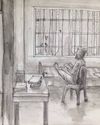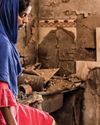
Docked in the choppy waters of a Venetian canal, along the warehouse architecture of the Arsenale—one of two venues of the 2019 Venice Biennale—is the ruin of a 90-foot fishing boat. Titled “Barca Nostra”—Italian for “our boat”—it forms part of a project by the Swiss-Icelandic artist Christoph Büchel. On the night of 18 April 2015, in waters between Libya and the Mediterranean island of Lampedusa, this boat capsized, and nearly eight hundred passengers drowned or were lost at sea. Each passenger was a migrant fleeing war or famine, hoping to seek refuge in Europe. Onboard were people from Syria, Gambia, Somalia, Sierra Leone, Senegal, Mali, Libya, Eritrea and Bangladesh. Only 28 people survived.
A year after it was wrecked, the boat was brought back to Sicily, where forensic experts combed through its interiors to segregate and identify the body parts and belongings left behind. The boat’s passage from Libya was an operation spearheaded by Mohammed Ali Malek, a Tunisian smuggler. Malek was seen brandishing a long wooden pole to keep his passengers in line while ferrying them to the boat in a small wooden dinghy. He contacted the Italian coastguard in Rome as soon as they hit international waters, asking for help. The coastguard responded by signalling a nearby Portuguese container ship. Witnesses saw Malek grab the steering wheel and slam it into the oncoming vessel. He was found guilty of manslaughter, and sentenced to 18 years in prison and a ¤9 million fine.
This story is from the September 2019 edition of The Caravan.
Start your 7-day Magzter GOLD free trial to access thousands of curated premium stories, and 8,500+ magazines and newspapers.
Already a subscriber ? Sign In
This story is from the September 2019 edition of The Caravan.
Start your 7-day Magzter GOLD free trial to access thousands of curated premium stories, and 8,500+ magazines and newspapers.
Already a subscriber? Sign In

Mob Mentality
How the Modi government fuels a dangerous vigilantism

RIP TIDES
Shahidul Alam’s exploration of Bangladeshi photography and activism

Trickle-down Effect
Nepal–India tensions have advanced from the diplomatic level to the public sphere

Editor's Pick
ON 23 SEPTEMBER 1950, the diplomat Ralph Bunche, seen here addressing the 1965 Selma to Montgomery March, was awarded the Nobel Peace Prize. The first black Nobel laureate, Bunche was awarded the prize for his efforts in ending the 1948 Arab–Israeli War.

Shades of The Grey
A Pune bakery rejects the rigid binaries of everyday life / Gender

Scorched Hearths
A photographer-nurse recalls the Delhi violence

Licence to Kill
A photojournalist’s account of documenting the Delhi violence

CRIME AND PREJUDICE
The BJP and Delhi Police’s hand in the Delhi violence

Bled Dry
How India exploits health workers

Status Update
India’s telling silence on the Hagia Sophia controversy